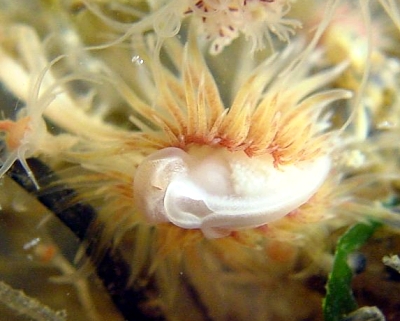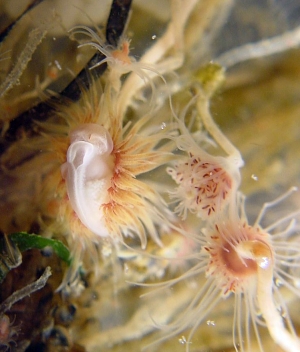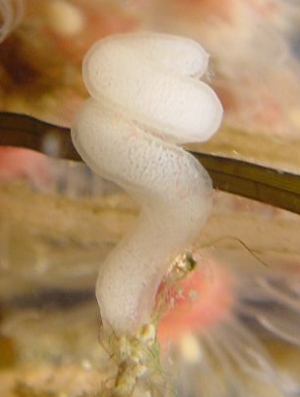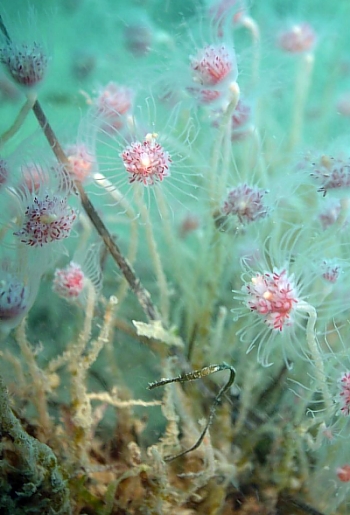Re: Cumanotus beaumonti and C. cuenoti
May 13, 2006
From: Marina Ossokine

Concerning message #16575:
Dear Bill,
I will try to answer your questions on Cumanotus cuenoti.
The food: I'm bad with hydroids, bryozoans, sponges and anemones identification. The food of this Cumanotus was identified as Ectopleura dumortieri by Gantes, that's why I used this name. But I agree it could be Tubularia indivisa as well. All I can do is to send you a better photo of it (see attached here).
The size and oral tentacles: I saw Cumanotus cuenoti in February and May in 2004, and in February-March in 2005. They are present in Arcachon Basin as long as their food is here. During these periods I saw dozens of specimens of this species and the largest ones were about 10 mm, no larger. I have never seen any specimen with oral tentacles. Please, see attached here photo which shows the head and foot morphology quite well : no oral tentacles nor foot corners visible here. I'm convinced all these animals were mature at this size because numerous egg-ribbons were covering the related food. And even the eggs shape is a little different from the photo in Cristian Magnani's message [#16466 ]: it is very consistent, corkscrew-shaped with close whorls, like in the attached photo.
So, to my opinion, Cumanotus cuenoti is distinct from C. beaumonti.
Distribution: Cumanotus cuenoti has also been seen in Gironde estuary, northern to Arcachon Basin.
Locality: 'Hortense', Cap Ferret, Arcachon Basin, 4-5m, France, Atlantic Ocean, February 23, 2006. Length: animal : 10 mm / eggs : 8 mm. Photographer: Marina Poddubetskaia Ossokine.
I hope this will help.
Best wishes,
Marina.
Nembro website
nembro@nembro.info



Dear Marina,
Thanks very much for all this extra information. I thought we would have to wait until your next visit to Arcachon. I am not a great hydroid expert either, but my understanding is that Ectopleura dumortieri is a solitary hydroid while yours is clearly a colonial form. I think it could well be Tubularia indivisa.
I also agree that there are no signs of oral tentacles or tentacular foot corners. Concerning size, many species start breeding before they reach full size, but I agree in this case, with so much food available, it would be strange if they had not grown to a larger size if they were capable of it. Apart from checking again, next time your in Arcachon, whether they stop growing before all the hydroid polyps are eaten, there is not much we can do without looking at some anatomy. One thing still left to check is whether Cristian can find small specimens of his species and see if they have tentacles.
Your messages and Cristian's have certainly given us a lot of new information on these rare species.
Best wishes,
Bill Rudman
Related messages
-
Re: Cumanotus from Slovenia
From: Marina Poddubetskaia, April 12, 2005
